A few months ago, I shared with you, on the one hand, my frustration about the lack of generally available market data about Microsoft Dynamics 365 Business Central. Not only, but especially when it comes to manufacturing. On the other hand, I also announced that I volunteered to contribute to closing the gap. This is done now. It is achieved via the State of Microsoft Dynamics 365 Business Central and Manufacturing Report.
The report is the result of an extensive market survey that was conducted in the time from November 2020 to the end of January 2021. It is meant to provide statistically relevant market data about Microsoft Dynamics 365 Business Central (and Dynamics NAV) and the degree it adopted and used by both manufacturing companies and partners selling to manufacturing clients. Hence, it shows findings from both surveying customers and partners - and from having received a whopping number of 318 responses. You can download the State of Microsoft Dynamics 365 Business Central and Manufacturing Report here.
Motivation to write the State of Business Central and Manufacturing Report
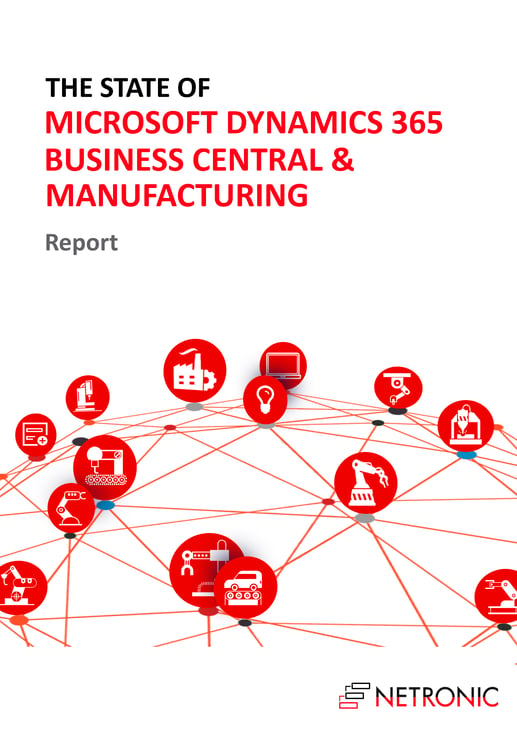 First: Both we as a company and I as a person have been dealing with Microsoft Dynamics and NAV and Business Central - with a focus on manufacturing - for eight years. In all those years, we have received advice, support, help, and even friendship from both customers and partners. Now we felt it about time to give something back to that unprecedented community.
First: Both we as a company and I as a person have been dealing with Microsoft Dynamics and NAV and Business Central - with a focus on manufacturing - for eight years. In all those years, we have received advice, support, help, and even friendship from both customers and partners. Now we felt it about time to give something back to that unprecedented community.
That "something" is this global market research study and its findings. I decided to leverage on our global network of partners and customers to conduct comprehensive market research about the current "State of Business Central and Manufacturing". We created the survey (in English, German, French, and Spanish), marketed the study, analyzed the findings, and now freely share them in this comprehensive report. We did this for free, and we also openly share the report for free.
Second: Besides the aim of “giving back”, it was mainly my curiosity that kicked off this project.
I am per se a curious person. Consequently, I am always interested in everything related to Microsoft Dynamics 365 Business Central and manufacturing. However, I tend to come up with questions that are not easy to answer. To some degree, I am convinced that there is a general lack of market data concerning Microsoft Dynamics 365 Business Central. So, I decided to step in.
Sample questions that triggered the report (and are answered with the report)
Here are some of the questions I could not find an “average users” answer to:
- What is the average timeframe until current NAV customers move to Business Central?
- How quickly is the rate on-prem > cloud changing to cloud > on-prem?
- Is a typical NAV / Business Central manufacturing company make-to-order, or make-to-stock, or somewhat both?
- What is the average batch size of a typical Business Central manufacturing client?
- What is the average number of daily new production orders that a Business Central customer must manage?
- What are typical challenges that manufacturers face when working with Dynamics NAV, Business Central, or any other ERP?
Before starting the project "State of Business Central and Manufacturing Report", the list could go on and on. With that in mind, we came up with our survey. I assumed we are not the only ones interested in the results, nor the only company who can learn from it and target the market better.
The demographics of the respondents
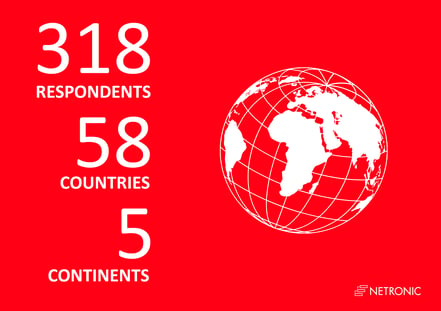 The questionnaire was answered by 318 different people. This means that the results are relevant from a statistical point of view, especially because they represent the global Microsoft Dynamics 365 Business Central / Dynamics NAV community: The 318 people who responded to the survey come from 58 countries, and span 5 continents.
The questionnaire was answered by 318 different people. This means that the results are relevant from a statistical point of view, especially because they represent the global Microsoft Dynamics 365 Business Central / Dynamics NAV community: The 318 people who responded to the survey come from 58 countries, and span 5 continents.
However, there is no equal split across the continents. Most of all respondents originate from Europe. Hence, isolated responses from Europe, North America, and Asia/Pacific are statistically relevant. If we look at isolated responses from Africa or South America, they are too few to be statistically relevant.
In addition to the question about where the respondents come from, it is also important to learn for which type of company they work. Therefore, we asked whether respondents work for a partner (differentiating between a reseller and an independent software vendor) or if they work for a customer using Microsoft Dynamics 365 Business Central or Dynamics NAV (differentiating between current customers and companies considering moving to Business Central).
- 70% of the respondents work for a partner reselling Microsoft Dynamics 365 Business Central and/or NAV.
- 16% (total: 53) of participants are Business Central / NAV customers. Hence, also the responses of the Business Central customers are relevant in a statistical sense.
- 14% work for a Business Central ISV (independent software vendor).
What we found out - answers to some sample questions
As outlined above, there were a few questions that initially triggered our idea to conduct market research among Microsoft Dynamics NAV and Dynamics 365 Business Central customers and partners. With the State of Business Central and Manufacturing Report, we found answers to these questions and happily share the results here (if you are interested in the full, 69-pages report, please download your free copy here).
Sample #1 - What is the average timeframe until current NAV customers move to Business Central?
35% of all responding customers plan an upgrade this year. Another 23% plan moving to Business Central in 2022. This means that almost 60% of all customers plan for an upgrade to Microsoft Dynamics 365 Business Central within the shorter term (red bars in the below chart). This again underlines the high level of acceptance that Business Central gains within the Dynamics NAV customer community.
On the contrary, 15% of all customers do not show any intention to upgrade (grey bar). This is also a comparably high figure and indicates a certain threat that customers also might use the – at some point required – change from Dynamics NAV to Dynamics 365 Business to look for / move to another ERP system.
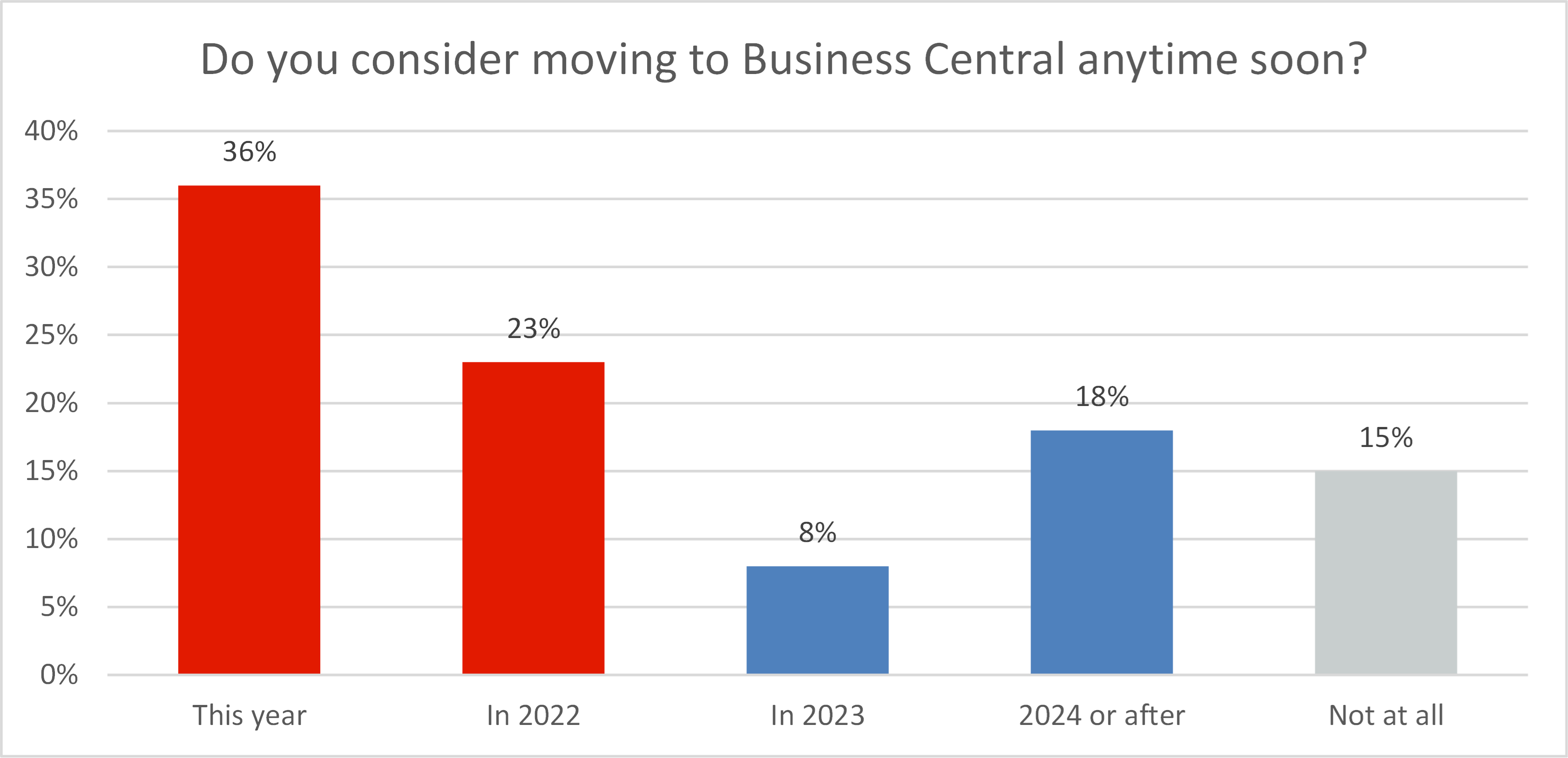
Sample #2 - How quickly is the rate on-prem > cloud changing to cloud > on-prem?
The question "do you consider moving to the cloud soon?" was asked to those respondents who previously replied that they (still) use their ERP system on-premises. While the answers to the previous question revealed a general movement to cloud-based ERP usage, this question points out a very low willingness to change from on-prem to cloud within the existing Microsoft Dynamics NAV customers.
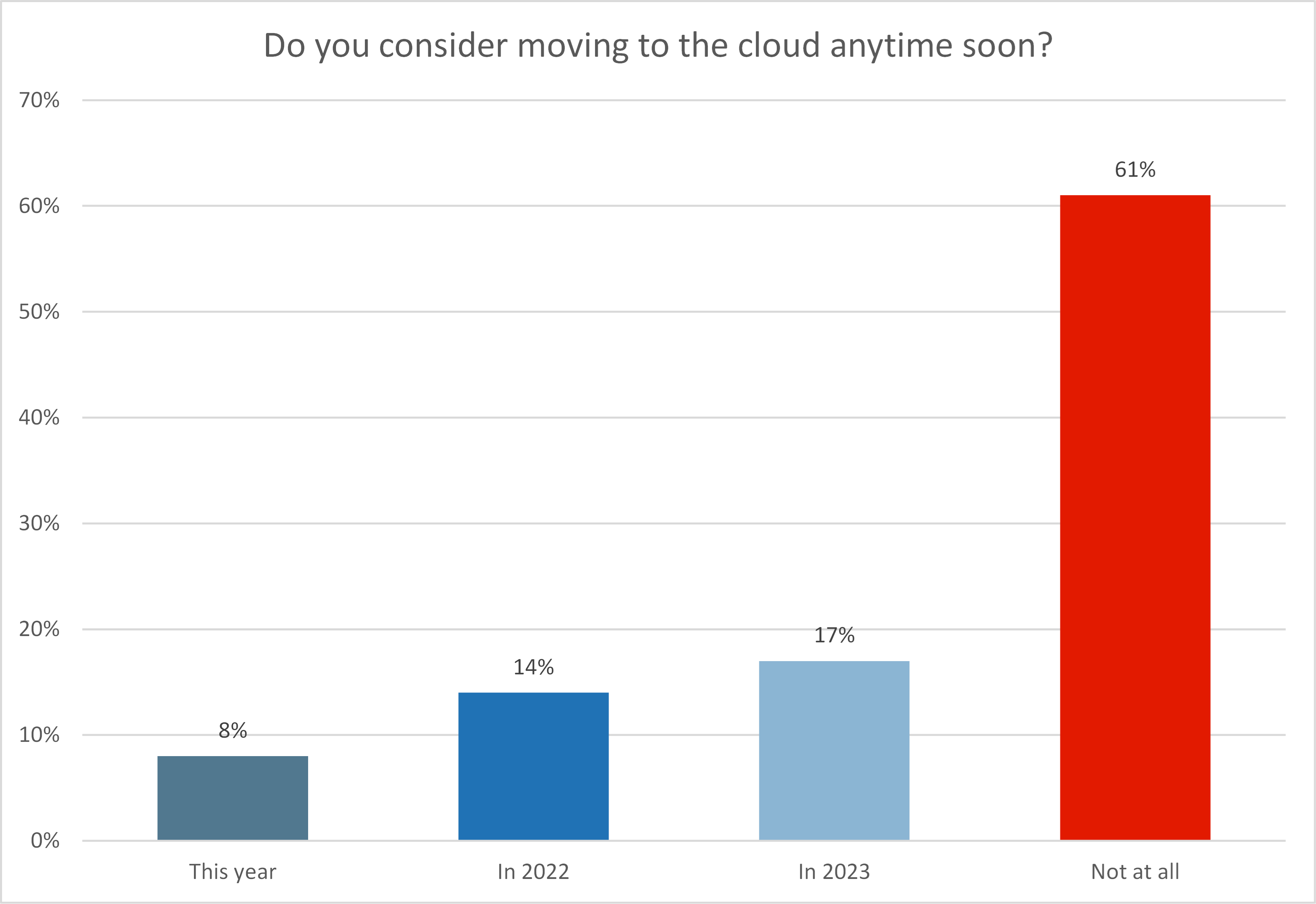 61% state that they do not at all consider moving their ERP to the cloud (red part of the chart), while 31% at least have mid-term plans to make the change from on-premises to cloud (in 2022 and 2023). Less than 10% of all current on-premises NAV customers want to make that change in the current year.
61% state that they do not at all consider moving their ERP to the cloud (red part of the chart), while 31% at least have mid-term plans to make the change from on-premises to cloud (in 2022 and 2023). Less than 10% of all current on-premises NAV customers want to make that change in the current year.
Correlation of cloud-(un)-willingness with years of ERP usage
We further drilled into that 61% which do not at all consider moving their ERP to the cloud.
- 36% of those call themselves “Dynamics NAV veterans” which means that they have been using Dynamics NAV for more than 8 years.
- Yet another 36% of those are experienced Dynamics NAV users. They have been using NAV for at least 3 and up to 8 years.
It is fair to assume that the unwillingness to change from on-premises to the cloud is related to high investments that customers made into their on-premises systems. These investments (either in ISV solutions or in customizations) typically are crucial to making the ERP work in a way that best supports the customers’ requirements.
Sample #3 - What was the main reason for choosing a Dynamics system?
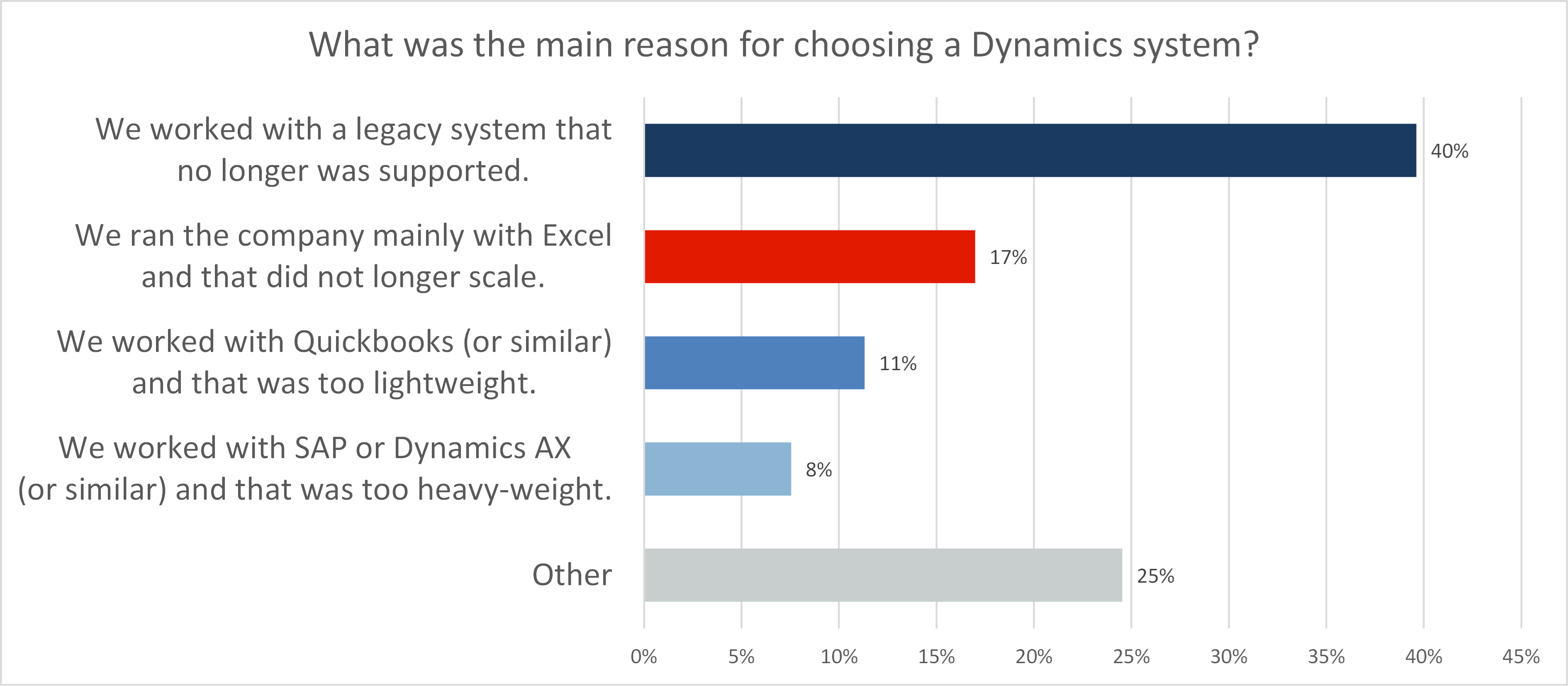
Overall, the blue-colored bars show that 59% of all respondents were already working with some type of ERP system before switching to Dynamics NAV or Dynamics 365 Business Central. This provides a string of evidence that for many customers Dynamics NAV is not the entry-level ERP system. The 59% can be broken down as follows:
- 40% of all customers decided for Dynamics NAV (or Business Central) because their legacy was no longer supported.
- 11% worked with Quickbooks (or similar) before and this system turned out to be too lightweight.
- 8% of the NAV customers went the opposite path: they worked with SAP or Dynamics AX (or similar) before, and this system was too heavyweight for them.
Only 17% of all respondents (red bar) said that they ran their company with Microsoft Excel before, which turned out to not scale anymore. For them – which is less than 1/5 of all customer respondents – Dynamics NAV and Dynamics 365 Business Central truly is the entry-level ERP system.
The 25% other responses provide the most diverse reasons for customers selecting a Dynamics system and do not show any further meaningful cluster.
Correlation of system used and reason for choosing the system
We then correlated the question for the reason of selecting a Dynamics system (question 10) with the concrete system that was selected (question 6; Dynamics NAV or Dynamics 365 Business Central). This revealed some additional insights:
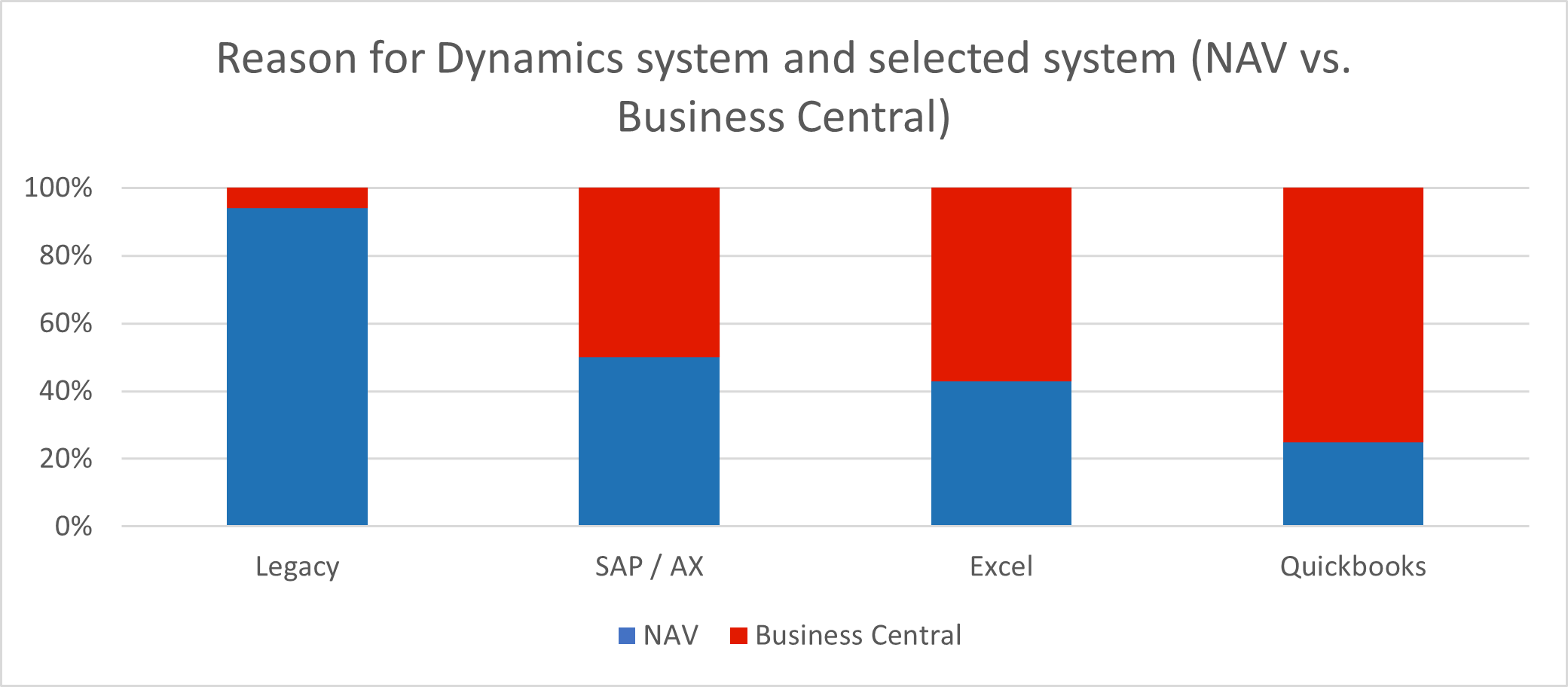
Whereas the existence of a legacy system to an almost dominant degree is only true for those customers who selected Dynamics NAV, many of the new Business Central customers have been using QuickBooks (75%) or Excel (57%) before. This can be seen as an indication, that – despite the similar core of NAV and Business Central Dynamics 365 Business Central to a much higher degree could become an entry-level ERP system. This could be due to the strong integration of Business Central with the well-known and widely adopted Office 365 suite.
Your next step: get the full report
The findings above are just a few selected examples from the full, 69-pages, State of Microsoft Dynamics 365 Business Central and Manufacturing Report. If you are interested in getting valid and meaningful market data about Business Central and manufacturing, I highly recommend that you download your free copy of this report.

